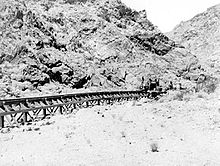Epsom Salts Monorail
| Epsom Salts Monorail | |
|---|---|
 |
|
| Overview | |
| Other name(s) | Magnesium Monorail |
| Type | monorail |
| Coordinates | 35°40′53.12″N 117°23′28.95″W / 35.6814222°N 117.3913750°WCoordinates: 35°40′53.12″N 117°23′28.95″W / 35.6814222°N 117.3913750°W |
| Stations | none |
| Operation | |
| Opened | 1924 |
| Closed | June 1926 |
| Owner | American Magnesium Company |
| Technical | |
| Line length | 45 km (28 mi) |
| Operating speed | 56 km/h (35 mph) |
| Highest elevation | 1,066.8 m (3,500 ft) |
The Epsom Salts Monorail or Magnesium Monorail was a short-lived Lartigue Monorail in San Bernardino County, California, in the United States. It was built to carry epsomite (hydrated magnesium sulphate) from a deposit in the Owlshead Mountains to a siding of the Trona Railway. It ran nearly due east from Trona, for a distance of about 28 mi (45 km). The monorail was opened in 1924 and closed in June 1926.
Thomas Wright, a florist from Los Angeles, set-up a camp in Crystal Hills Wash in 1918 and prepared an area for salt mining, where he had previously found some minerals. He and his reconnaissance team needed to transport their supplies by lorry from Randsburg on inadequate tracks over a distance of 40 miles (63 km). Building a narrow gauge railway line was considered to be too expensive, so that they decided to build a monorail on wooden trestles. They founded the American Magnesium Company to construct the monorail track from freshly logged Douglas firs, which were shipped to San Pedro and then transported by the Trona Railway to the sidings at Magnesia near Searles. Construction began in 1922 and by September they had passed the half-way point with 15 of 28 miles (25 of 45 km).
The monorail was completed and inaugurated in 1924. It became known as the 'fastest monorail of the world', because it could pass the 28 miles (45 km) long track fully loaded within an hour. However, it transported less salt than originally estimated within the first two years of its use.
The mine employed 12-15 workers in 1924/25. The epsomite could initially be scraped from the surface by gardener's tools, but the high-quality minerals were quickly depleted, and the remainder was mixed with 50% contaminates of sand, debris and other salts. The return on investment was hampered by the high transportation cost to the factory of the American Magnesium Company in Wilmington, especially caused by the high maintenance cost for the wooden track, which distorted when the beams dried, by initially inappropriate locomotives and by landslides which damaged the track. The mine was closed in 1926. As no buyers could be found for the complete installation, only a small percentage of the initial investments could be rescued during the liquidation of the company.
...
Wikipedia
